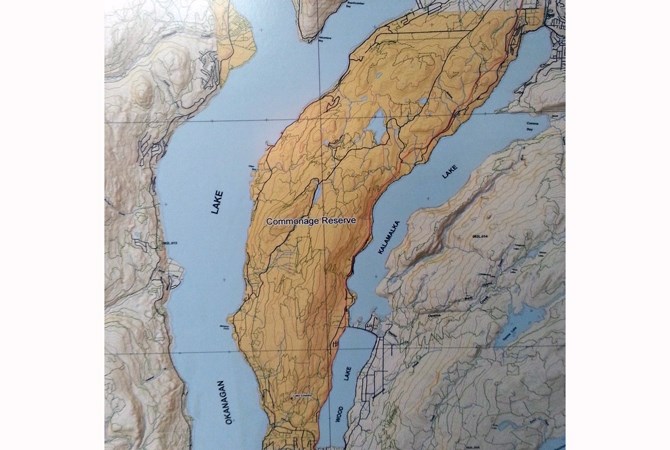
Map of the Commonage Reserve area.
Image Credit: OKIB
March 26, 2015 - 1:11 PM
VERNON - With the impending sale of the discontinued rail corridor between Vernon and Kelowna, the Okanagan Indian band has revived a historic land claim on a large tract of land known as the Commonage Reserve.
Formed in 1877 by the Joint Indian Reserve Commission (established by the governments of Canada and B.C. to create reserves for the benefit of First Nations) the Commonage stretched all the way from what is now Oyama to the Vernon Army Base. The three-man commission was made up of Alexander Caufield Anderson, Archibald McKinlay (former Hudson’s Bay Company officials) and a businessman named Gilbert Malcolm Sproat. The commissioners created the 28,000 acre Okanagan Commonage Reserve on Oct. 15, 1877 to be used as pasturage for both First Nations and non-native settlers in the area. The commission seemed unsure of its own authority to create a joint-use commonage area, stating if “the arrangement cannot be made, then the land is to be an Indian reserve.”
According to the Okanagan Indian Band, it wasn’t long before “secret meetings” between Premier William Smithe and Prime Minister Sir John A. MacDonald resulted in the relinquishing of the band’s rights to the land. In a short documentary titled Voices of the Land, band members recall how their ancestors were not consulted about the decision, or even aware the negotiations were taking place until the government began auctioning off land in 1893. Meanwhile, the Indian Reserve Commissioners established a new reserve on the north west side of Okanagan Lake.
In the early 1900s, the Canadian Northern Pacific Railway Company built a railroad from Kelowna to Vernon that passed through a large portion of the Commonage lands. The railroad eventually changed hands and was operated by the Kelowna Pacific Railway until its bankruptcy in August 2013. CN Rail took over the network, but discontinued service on the section between Kelowna and Vernon. Municipalities are now attempting to purchase the land from CN with plans to make it into a multi-use trail.
Under the leadership of Chief Murray Alexis, the Okanagan Indian Band first brought its claim for the Commonage Reserve forward in 1989 under Canada’s specific claims policy. It wasn’t until 2000 that the government accepted the claim for negotiation. According to Aboriginal Affairs, the government turned down the claim and concluded it in 2008 with “no lawful obligation found.”
The Okanagan Indian Band’s recent notice of claim filed in B.C. Supreme Court represents the latest move in the band’s fight to have the land returned to them. The band asserts that the Commonage Reserve included travel routes, as well as important sacred, fishing, hunting and gathering grounds. It argues that when rail operations ceased to occur, the property legally reverted back to reserve land.
Today, the area, which is flanked on one side by Okanagan Lake and Kalamalka Lake on the other, contains a number of housing developments, as well as the Predator Ridge Golf Resort.
To contact the reporter for this story, email Charlotte Helston at chelston@infonews.ca or call 250-309-5230. To contact the editor, email mjones@infonews.ca or call 250-718-2724.
News from © iNFOnews, 2015